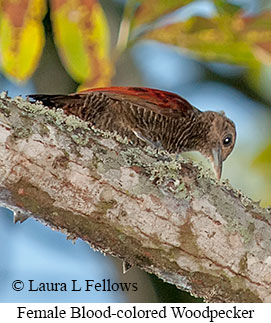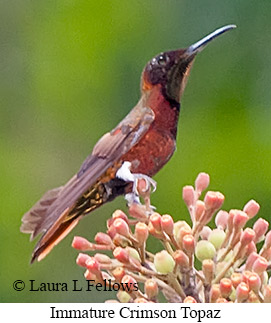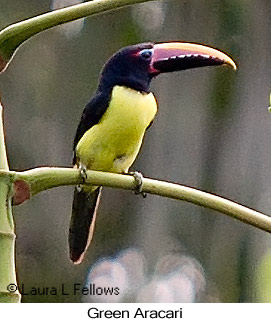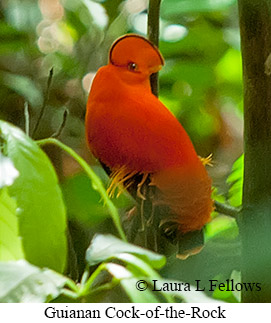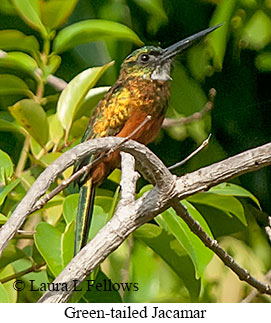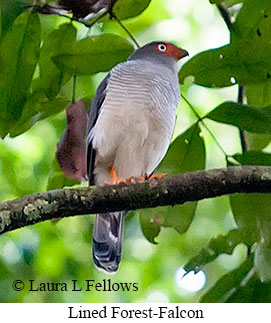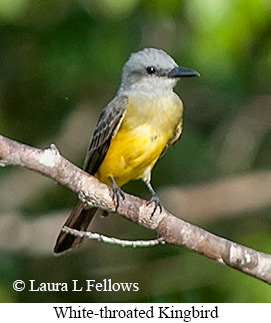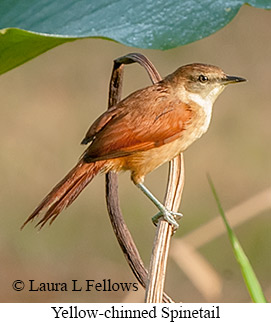CLASSIC GUYANA TOUR PLUS THE SOUTH
Tour Description

GUYANA
BIRDING TOUR
ANY TIME*
| Duration: | 15 days, 14 nights |
| Group Size: | 2-8 |
| Anytime Price: | €7875 |
| Group Price: | €7575 |
| Single Suppl: | €500 |
| Est #Species: | 320-350 |
| Pace: | Easy |
| Difficulty: | Easy/Moderate |
| * This tour is available for any dates of your choosing provided guide services and accommodations are available. | |
DAY 1 - GEORGETOWN
Arrive at international airport outside Georgetown and transfer to Cara Lodge, one of the nicest places to stay in Georgetown. Those arriving at night (please check with us before booking your flight) will be met at the airport. Anyone arriving earlier can arrange transfer through the airport taxi service. Transfer cost not included in tour price. Night at Cara Lodge.
DAY 2 - HOPE BEACH, MAHAICA RIVER, GARDEN OF EDEN
Depart early for Hope Beach, about an hour's drive from the hotel. The mudflats are the best place to find Scarlet Ibis near Georgetown. The beach is also good for various shorebirds. Following a fairly short stop, continue east to the Mahaica River for a boat trip up the river. Birds of interest inlude the locally distributed Rufous Crab Hawk. Of special interest along the trail is White-bellied Piculet. Other coastal specialties include White-barred Piculet, Spot-breasted Woodpecker, Black-crested Antshrike, Carib Grackle, and Yellow-hooded Blackbird. En route back to Georgetown, look around the extensive rice fields for raptors such as Long-winged Harrier.Afternoon bird Garden of Eden as time permits where flowering plants attract hummingbirds and other species. Possibilities there include Azure Gallinule, Little Cuckoo, Fork-tailed Woodnymph, Plain-bellied Emerald, Glittering-throated Emerald, White-chinned Sapphire, Gray Kingbird, and Wing-barred Seedeater. Night at Cara Lodge.
DAY 3 - GEORGETOWN & IWOKRAMA FOREST RESERVE
Early visit to Georgetown Botanical Gardens, a good place to see the Guianan endemic Blood-colored Woodpecker, found only near the coast. View several species of macaws and parrots as well as a variety of other birds before transferring to airport. This will be the only chance for Festive Parrot. After breakfast fly over hundreds of miles of Amazon rainforest marred only by an occasional gold-mining operation, arriving at Lethem mid day. Transfer through the Rupununi Savanna to Iwokrama Field Station on the banks of the Essequibo River. Late afternoonoon bird the mile-long Screaming Piha Trail through a forest of giant Mora trees as time permits. Possibilities include Bronzy Jacamar, Waved Woodpecker, Chestnut Woodpecker, Amazonian Antshrike, and Strong-billed Woodcreeper. Also possible are Red-mantled Howler Monkeys in the forest canopy or mid-story. Around the clearing at the field station Red-capped Cardinal is quite common while Red-throated Caracara is a definite possibility. Night at Iwokrama Field Station.
DAY 4 - IWOKRAMA FIELD STATION
After early coffee/tea, set out for Turtle Mountain Trail, reached by a half-hour boat trip up the Essequibo River. Along the river are Blue-throated Piping-Guan and other species. The first section of trail is mostly level and goes through seasonally flooded varzea forest where likely birds include Black Nunbird, Helmeted Pygmy-Tyrant, and Tiny Tyrant-Manakin. Also possible for the lucky few is Guianan Red-Cotinga. A family of Giant Otters is usually present in the oxbow lagoon. Box breakfast at a tent camp used on occasion by researchers. The clearing there is the best place to find Red-fan Parrot. Continue gradually uphill into terra firme forest. The best birding is before the steepest section below the top. In the forest the shy Gray-winged Trumpeter often appear before scurrying off. Look for the striking near endemic Red-and-black Grosbeak, most likely found about half way up the trail. Other likely birds include Black Nunbird, Spot-tailed Antwren, Todd's Antwren, Ferruginous-backed Antbird, Rufous-throated Antbird, Spotted Antpitta, Cinnamon-rumped Foliage-gleaner, McConnell's Flycatcher, Buff-cheeked Greenlet, and Yellow-green Grosbeak. Return to the field station for lunch.
Afternoon bird the main dirt road through primary rainforest by vehicle. The birding is excellent as traffic is minimal. This could change in future as the government is considering a major upgrade to the road, which will bring traffic from heavy oil tankers. Specialty birds along the road include Crimson Topaz, Guianan Puffbird, Paradise Jacamar, Black-spotted Barbet, Green Aracari, Guianan Toucanet, Red-throated Caracara, and Caica Parrot. Other interesting birds include Yellow-tufted Woodpecker, Red-necked Woodpecker, Bat Falcon, Chestnut-fronted Macaw, Red-and-green Macaw, Black-headed Parrot, Silvered Antbird, Purple-throated Fruitcrow, and Green Oropendola. Shortly before dusk stop at Mile 26 and wait for dark. Jaguars are regularly seen crossing the road at this spot. After dark look for owls and nightjars. Likely species are Blackish Nightjar, Amazonian Pygmy-Owl, Black-banded Owl, and Common Potoo. Night at Iwokrama Field Station.
DAY 5 - IWOKRAMA FIELD STATION
Early morning return to the main road to bird a little known trail looking for Red-billed Woodcreeper, Boat-billed Tody-Tyrant, and Cinnamon-crested Spadebill, all difficult species to see. Remainder of day birding Greenheart, Woodcreeper, or other trails near the field station to pick up species missed the previous day. Possibilities include Crestless Curassow, Guianan Slaty-Antshrike, Olivaceous Woodcreeper, Buff-throated Foliage-gleaner, and Sooty-headed Tyrannulet. Night at Iwokrama Field Station.
DAY 6 - MORI SCRUB & ATTA RAINFOREST
Depart early for Mori Scrub along the main road through Iwokrama, a seasonally flooded, sandy habitat harboring several very localized birds. The area is best visited later in the dry season during January-March when the trail is no longer under water. The trail is mostly flooded October-November. Birds of special interest are White-chinned Sapphire, Spotted Puffbird, Rufous-bellied Antwren, Rufous-crowned Elaenia, Helmeted Pygmy-Tyrant, Black Manakin, White-crowned Manakin, and Red-shouldered Tanager. The southern half of the loop trail is on higher ground through dry forest where the secretive Rufous-vented Ground-Cuckoo is possible. Arrive at Atta Rainforest Lodge near the southern end of Iwokrama late morning. Mid-day relax and enjoy a leisurely lunch. Black Curassows regularly appear in the clearing around the lodge.
Afternoon ½ hour walk to canopy walkway, which consists of 5 platforms mounted on trees and interconnected by a series of suspended walkways. The walkway is especially good for seeing macaws, parrots, woodpeckers, and antbirds of the forest canopy. Specialty birds include Black Nunbird, Paradise Jacamar, Black-spotted Barbet, Guianan Toucanet, Caica Parrot, Spot-tailed Antwren, Todd's Antwren, Ash-winged Antwren, Ferruginous-backed Antbird, Guianan Red-Cotinga, and Blue-backed Tanager. Other possibilities include Amazonian Motmot, Waved Woodpecker, Chestnut Woodpecker, Ringed Woodpecker, Red-necked Woodpecker, Painted Parakeet, Golden-winged Parakeet, Bronze-winged Parrot, Dusky Parrot, Mouse-colored Antshrike, Black-throated Antbird, Amazonian Barred-Woodcreeper, Gray-crowned Flycatcher, Ruddy-tailed Flycatcher, Pompadour Cotinga, Slaty-capped Shrike-Vireo, Long-billed Gnatwren, Yellow-winged Tanager, Spotted Tanager, Blue Dacnis, Purple Honeycreeper, and Slate-colored Grosbeak. Stay until dark to look for White-winged Potoo in forest canopy. Night at Atta Rainforest Lodge.
DAY 7 - ATTA RAINFOREST & SURAMA
Early morning return to canopy walkway to look for birds missed the previous afternoon. On the trail back to the lodge, look for Ruddy Quail-Dove. After breakfast drive the short distance to Cock-of-the-Rock Trail and walk about 20 minutes slightly uphill through secondary forest to an area of large boulders where Guianan Cock-of-the-Rock nests. The male is usually present in this area. Known display leks are all long hikes to reach, which is why most groups visit this site to see the species. A little farther down the main road is an unmarked trail to a Harpy Eagle nest. If the nest is active, walk about an hour into the forest to view the nest and hopefully an adult Harpy Eagle. Drive to Surama Village for lunch at a rustic lodge. After lunch bird the area around the village. Of particular interest is Cayenne Jay, only found there. Other birds are Brown-throated Parakeet, Golden-winged Parakeet, Green-tailed Jacamar, Green Aracari, Red-breasted Blackbird, and Finsch's Euphonia. At dusk visit a roosting site where Great Potoo and Common Potoo are usually present. Night at Surama Lodge.
DAY 8 - SURAMA, BURRO BURRO RIVER, ROCK VIEW
Early morning drive beyond Surama to the nearby Burro Burro River, arriving by 6:00 AM. Float down the slow-moving river looking for the near endemic Guianan Streaked-Antwren, which lives almost exclusively along river courses. After box breakfast, bird the dirt track back through secondary forest toward Surama on foot. The forest offers some great birding with possibilities that include Marail Guan, Cream-colored Woodpecker, Lined Forest-Falcon, Guianan Slaty-Antshrike, White-flanked Antwren, White-fringed Antwren,Rufous-bellied Antwren, Guianan Warbling-Antbird, Ferruginous-backed Antbird, Gray Antbird, Dusky Antbird, White-browed Antbird, Black-chinned Antbird, White-bellied Antbird, Chestnut-rumped Woodcreeper, Capuchinbird, White-crowned Manakin, Golden-headed Manakin, Coraya Wren, and Guira Tanager.
Lunch in Surama. Afternoon bird Rupununi Savanna, stopping as time permits to look at hummingbirds around Rock View. Possibilities include Buff-necked Ibis, Pearl Kite, Green-tailed Jacamar, Aplomado Falcon, Black-crested Antshrike, Guianan Warbling-Antbird, Cinnamon Attila, Amazonian Scrub-Flycatcher, and Large-billed Seed-Finch. Continue south to Karanambu. The habitat is mainly open scrub and savanna with one marshy area along the road. Look for nightjars at dusk. Up to 8 species are possible. The likeliest are Band-tailed Nighthawk, and White-tailed Nightjar. Night at Karanambu Lodge.
DAY 9 - KARANAMBU
After early breakfast, set out for the savanna where a local tracker has probably found a Giant Anteater to see. All morning bird the savanna and forest patches along water courses. Of special interest are Bearded Tachuri and Pale-tipped Inezia. Afternoon bird forest patches near the lodge. Possibilities include Undulated Tinamou, Cream-colored Woodpecker, Guianan Slaty-Antshrike, Swainson's Flycatcher, Bicolored Wren, and Grassland Yellow-Finch. After dark look for nightjars again along the nearby grass landing strip. Night at Karanambu.
DAY 10 - KARANAMBU & TRANSFER TO KARASABAI
Morning birding around Karanambu, looking especially for Crestless Curassow. Bird river-bottom along Rupununi River for Agami Heron, White-bellied Antbird, Scale-backed Antbird, Helmeted Pygmy-Tyrant, Short-crested Flycatcher, and Blue-backed Manakin. After lunch drive to Manari Ranch, birding en route. Night at Manari Ranch.
DAY 11 - KARASABAI
Karasabai is rarely visited by birding tours due to its limited accommodations and remote location, but it has a special treat in store. It's the only place in Guyana where the critically endangered Sun Parakeet can be seen. This species has been hunted nearly to extirpation and will be the bird of the trip. Other possibilities for the day include Maguari Stork, Green-rumped Parrotlet, Crested Doradito, Yellow-hooded Blackbird, and Orange-backed Troupial. We're also likely to see Giant Anteater on the open savanna. then return to Manari Ranch mid afternoon. Late afternoon birding around the ranch as time permits. Early evening look for nightjars. Night at Manari Ranch.
DAY 12 - RIO IRENG & TRANSFER
Depart early for motorized boat trip down Rio Ireng to a known location for both Hoary-throated Spinetail and Rio Branco Antbird. The boat trip to this site takes about an hour each direction. Both birds reside within a few hundred yards of the river but prefer slightly different habitats. The spinetail is an endangered species found in seasonally flooded gallery forest with an understory of dense thickets. The antbird is a threatened species found in dense thickets along the river edge, also in gallery forest though typically in forest with taller trees. Both species have always had limited distribution and small populations but are now seriously threatened by habitat destruction in much of their range. Also of special interest are Rufous-tailed Foliage-gleaner and Sirystes, both widely distributed Amazonian species whose ranges barely reach this area. Afternoon transfer to Wichabai Lodge, a separately owned property 3km north of the Dadanawa Ranch buildings, birding en route. Night at Wichabai Lodge.
DAY 13 - DADANAWA
The primary target bird this day is the endangered Red Siskin, a species nearly extirpated throughout its normal range in Venezuela and Colombia due to trapping for the cage bird trade. They were thought to be nearly extinct until 2003 when a large population of some 4000 individuals was discovered in relatively remote areas on Dadanawa Ranch in southern Guyana. Amazingly, the population at Dadanawa is some 1000 km. from the bird's previously known range. Red Siskins have been found at several sites on ranch land. Most of the sites are in remote areas quite far from the ranch buildings, but recently a more accessible site nearer the ranch has been discovered.
If the birds are still there, the early morning will be spent birding riverine habitat and savanna near the ranch. Otherwise, that time will be needed to go farther afield in search of the siskins at a more remote site where they are most reliably seen. Other birds to be expected include Crested Bobwhite, Jabiru, Buff-necked Ibis, White-tailed Hawk, Zone-tailed Hawk, Double-striped Thick-knee, Southern Lapwing, South American Snipe, Short-tailed Swift, Fork-tailed Palm-Swift, White-throated Kingbird, Saffron-crested Tyrant-Manakin, Yellowish Pipit, Hooded Tanager, Yellow-bellied Seedeater, and Blue-naped Chlorophonia. Afternoon transfer back to Manari Ranch. Night at Manari Ranch.
DAY 14 - RIO TAKUTU & GEORGETOWN
Morning boat trip along the Rio Takutu. Possible birds along the river include Sungrebe, Tepui Swift, Ruby-topaz Hummingbird, Racket-tailed Coquette, Fiery-shouldered Parakeet, Long-winged Antwren, Willis's Antbird, Guianan Tyrannulet, Guianan Gnatcatcher, and Riverbank Warbler. Interesting mammals include Gray River Dolphin and Pink River Dolphin. Mid-day flight to Georgetown, arriving mid-afternoon. Remainder of afternoon free to relax at the hotel, bird the nearby botanical gardens again, or take an organized city tour (not included in tour price) to see historical buildings and other points of interest in Georgetown. Night at Cara Lodge.
DAY 15 - END OF TOUR
Tour ends with breakfast at the hotel. After breakfast transfer to airport for international flights home (not included in tour price).
TOUR NOTES
Tour price does not include meals in Georgetown. Price is $500 lower if choosing to stay at nearby Cairns House instead of Karanambu Lodge.
ADDITIONAL INFO
(Not on Menu Above)
BIRDING LOCALES
